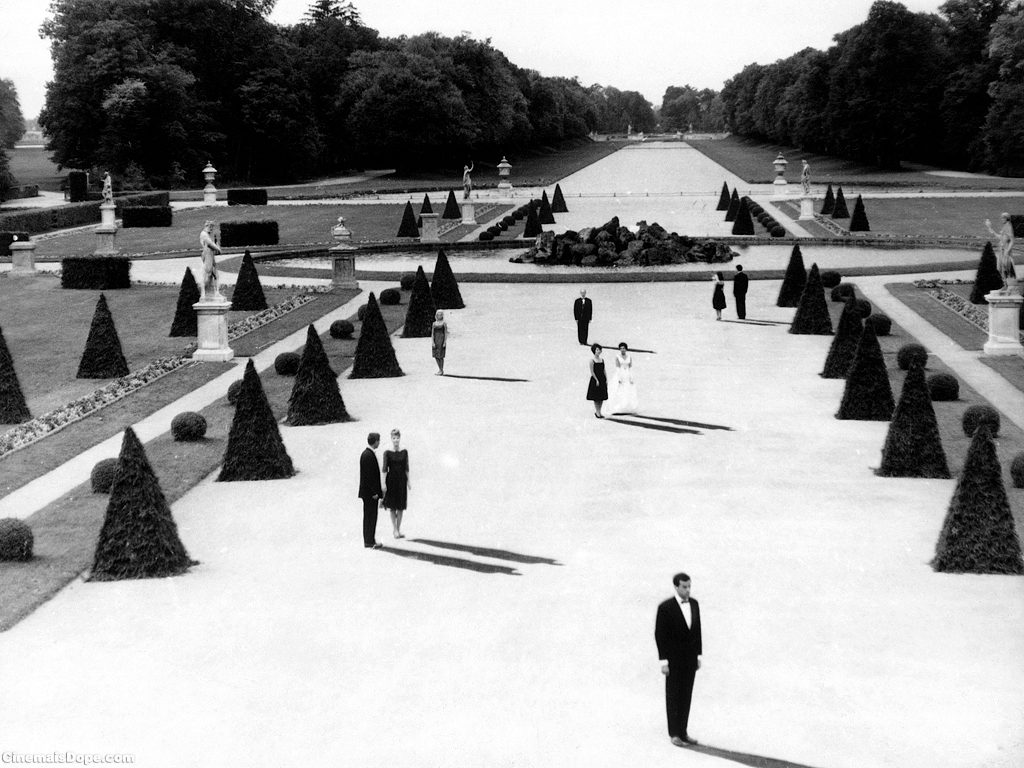Nouvelle Vague
Readings:
Mandatory movie for this learning unit:
- Breathless (Jean-Luc Godard, 1960)

Last Year at Marienbad. Photo Courtesy Rialto Pictures.
Auteur
- Roger Leenhardt and André Bazin (“revue du cinema”)
- In 1951, Jacques Doniol-Valcroze founded the monthly magazine “Cahiers du cinema” (cinema notebooks).
- André Bazin immediately joined this magazine and became the guru of auteur cinema.
- The directors we now associate to this movement (Eric Rohmer, Claude Chabrol, Jean Luc Godard, or François Truffaut) started their career as film critics in this legendary magazine.
- These younger film critics soon became more radical than their master André Bazin, who still recognized some classic Hollywood directors as auteurs, such as John Ford, Howard Hawks or Alfred Hitchcock.
- They thought that we can just talk about auteur cinema when the same person write an original script and direct the movie.
- Examples of authorship:
- Luis Buñuel (1900 –1983)
- Ingmar Bergman (1918 – 2007)
- Akira Kurosawa (1910 – 1998)
- Federico Fellini (1920 – 1993)
- Michelangelo Antonioni (1912 – 2007)
- Robert Bresson (1907 – 1999)
- Satyajit Ray (1921 – 1992)
Nouvelle Vague – The New Wave
- We can circumscribe this term for the movies made in France in the decade between 1958 and 1968.
- The Nouvelle Vague (New Wave) is a very intellectual and, frequently, politically oriented movement.
- “Camera Stylo” principle (the Camera pen). The director is the only creator and he uses the camera like the writer uses his pen.
- Therefore, they used
- light cameras, which allowed them to work without tripods,
- reflex viewfinders that showed exactly what the lens saw,
- highly sensitive photographic material, that allowed them to get reasonably good exposures with available light, and
- direct sound.
- Another important innovation is the disrespect for the continuity.
- The effect of discontinuity was a revolution because the intellectual and cultural elite of the 1960ies thought to recognize in it some fresh narrative air.
- They tried to break the spellbound of fiction.
Directors
François Truffaut (1932 – 1983)
- Probably the most passionate of all film makers of this generation.
- He was a cinéphile, a film lover, and had a very deep cinematographic culture. He venerated classic film makers as Alfred Hitchcock, Fritz Lang, Jean Renoir or John Ford.
- He was the protégé of André Bazin, and was a very controversial critic in Chaiers du cinema. A fanatic supporter of the author theory.
- But Truffaut progressively took distance from the narrative experiments of his friends and his last movies are very conventional (and paradoxically did not have success either in the box office, or in the critiques).
- He achieved huge reputation with his first feature films:
- Les quatre cents coups (The 400 Blows) in 1959, is considered the first full-length movie of the Nouvelle Vague.
- Other important movies during the nouvelle vague decade are:
- Tirez sur le pianiste (1960, Shoot The Pianist)
- Jules et Jim (1962)
- Fahrenheit 451 (1966),
- La Sirène du Mississipi (1969, Mississippi Mermaid)
- La nuit américaine (1973, Day for Night).
- He died very young, in 1983, of the consequences of a brain tumor, but he had an extremely prolific and passionate career as producer, actor and director of almost 30 movies.
Alain Resnais (1922 – 2014 )
- He is the most cultivated and radical of all the nouvelle vague directors.
- His movies are highly intellectual and shocking.
- In his movies during the 60ies, Resnais experimented with all possible narrative means:
- He mixed real conversation, imaginary dialogues and thoughts in the sound track, thus it was difficult to know who was saying what.
- In his movies, we see actually story action with documentary scenes.
- He also used bold flashbacks with no evident transitions between different times
- Resnais also blended real time, memory, fantasies and even dreams without defining the limits between then.
- His most famous movies are:
- Hiroshima mon amour (1959)
- L’année dernière à Marienbad (1962, Last Year at Marienbad)
- Mon oncle d’Amerique (1980)
Jean-Luc Godard (1930 – )
- The son of a very wealthy French-Swiss family.
- Although he was born in Paris, he became a Swiss citizen during World War II to avoid enrollment
- In 1952, he joined Cahiers du cinema, and started so his writing film criticism.
- Godard was the most provocative of all the film makers of the nouvelle vague. He always tried to attack the establishment.
- He soon understood that controversy brings success.
- Stylistic elements in Godard’s Films:
- Hand held camera work
- Jerky editing
- Fragmentary collage structure
- Some of his movies:
- À bout de soufflé (1960, Breathless)
- Une femme e une femme (1961, A Woman Is A Woman)
- Alphaville (1965)
- Pierrot le fou (1965)
- Week End (1967)
- During the 80ies he had no more creative energy and he just wanted to shock.
- Passion (1982)
- Marie (1983)
- Prenom Carmen (1983, First Name: Carmen)
